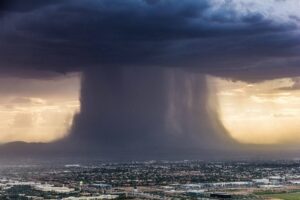GS3 – Disaster Management

Context
A recent cloudburst near Dharali village in Uttarkashi district, Uttarakhand, led to the flooding of the Kheerganga river, triggering flash floods, landslides, and resulting in loss of lives and property.
What is a Cloudburst?
A cloudburst is a sudden and highly concentrated rainfall event, typically depositing ≥100 mm of rain per hour over a small area of 20–30 km².
Key Features:
- Formation: Occurs within cumulonimbus clouds in moisture-rich and unstable atmospheric conditions.
- Langmuir Effect: Explains how raindrops coalesce within clouds until gravity overcomes updrafts, causing a sudden, heavy downpour.
- Elevation: Common between 1,000–2,500 metres, especially in Himalayan regions like Uttarakhand and Ladakh.
- Seasonality: Most frequent during June–August, driven by the southwest monsoon surge.
- Compound Risks: Cloudbursts combine meteorological and hydrological hazards, leading to multi-hazard disasters.
- Climate Change Link: The IPCC warns of increasing cloudburst frequency due to global warming and rising extreme rainfall events.
Causes of Cloudbursts
- Orographic Lift: Mountains force moist air upward, enhancing condensation and cloud formation.
- Atmospheric Instability: Rapid shifts in temperature and pressure create convective cloud systems.
- Airmass Convergence: Interaction between moist monsoon air and dry air enhances vertical movement.
- High Humidity: Increases cloud saturation, leading to faster precipitation formation.
- Low Pressure Systems: Stimulate vertical air currents in mountainous catchments.
- Lightning Delay: Delayed electrical discharge can trap latent energy, intensifying cloud moisture load.
Associated Hazards
- Flash Floods: Instantaneous water surges sweeping away infrastructure and people.
- Landslides: Water-logged slopes collapse, damaging roads, homes, and transport links.
- Debris Flows: Mud, stones, and vegetation rush downhill as dangerous slurries.
- Ground Collapse: Excess saturation weakens soil layers, causing sinkholes or subsidence.
- Riverbank Erosion: Strong runoff undermines banks, threatening nearby settlements.
- Landslide Lakes: Temporary damming of rivers, prone to sudden breaching.
- Siltation: Riverbeds and reservoirs fill with sediment, lowering storage capacity.
- River Course Alteration: Persistent erosion shifts natural drainage lines, increasing flood risks downstream.
NDMA Guidelines for Cloudburst Preparedness
- Risk Zoning: Use GIS tools and terrain analysis to map cloudburst-prone microzones.
- Radar Infrastructure: Expand Doppler radar coverage in high-risk hill districts.
- Land Use Regulation: Implement slope-based construction norms using microzoning.
- Drainage Planning: Design urban drains to handle short-duration, high-intensity rainfall.
- Rescue Preparedness: Train terrain-ready emergency teams with modern rescue gear.
- Rapid Response Deployment: Position mobile units with emergency power and communication tools.
- Mock Drills: Conduct annual simulations in vulnerable regions to test readiness.
- Early Warning Systems: Issue alerts via SMS, mobile apps, or sirens based on predefined rainfall thresholds.




